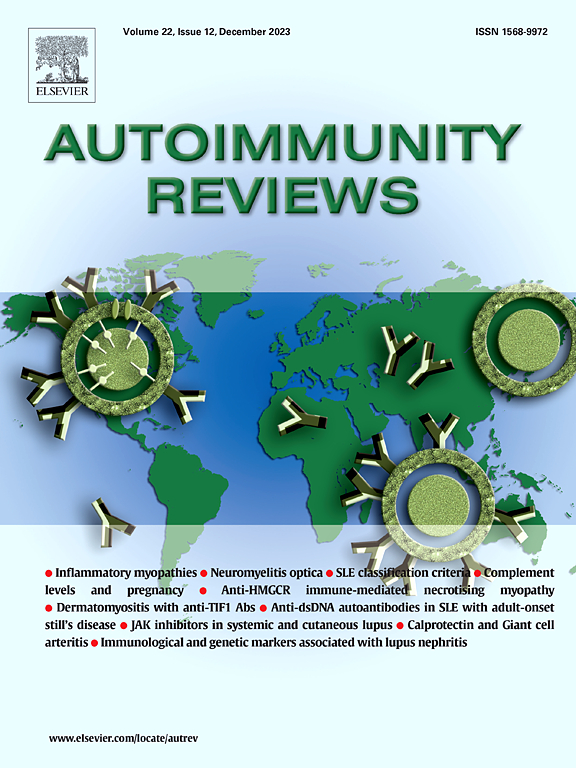评估和管理的骨骼健康在儿科起病风湿病从早期到成年期:一个关键的概述。
IF 8.3
1区 医学
Q1 IMMUNOLOGY
引用次数: 0
摘要
尽管现代风湿病学取得了进步,但患有儿科起病的风湿病患者仍然暴露于全身和/或关节炎症和皮质类固醇治疗中,所有这些都对生长中的骨骼产生不利影响,同时风湿病患者通常会经历体重减轻和缺乏体育活动。儿童骨量的评估存在计算局限性:双能x线吸收测量法(DXA)低估了骨密度(BMD),特别是在骨较小的情况下,这种情况经常发生在患有风湿病的儿童中,因为身高矮小或青春期延迟的比例很高。青少年特发性关节炎(JIA)患者的低骨密度率在3 %至34 %之间,系统性和多关节性JIA患者的低骨密度率更高;青少年发病的系统性红斑狼疮(jSLE)患者约有1/3的病例表现为低骨密度。这种骨密度降低在病程早期出现,随年龄增长而持续,但可能通过风湿病治疗逆转。在儿科人群中,骨质疏松症一词应保留给临床相关骨折的儿童,更倾向于“骨密度与实足年龄相符”。JIA椎体骨折的患病率在10 %至30 %之间,在10-15 岁的女性JIA患者中达到高峰,在jSLE中患病率在21.4% %至52 %之间。虽然所有患有风湿病的儿童患者应优化钙和维生素D的补充,但双磷酸盐应保留给脆性骨折患者;在糖皮质激素治疗的儿童中,预防骨折的初级处方仅推荐在剂量的情况下使用本文章由计算机程序翻译,如有差异,请以英文原文为准。

The assessment and management of bone health in pediatric-onset rheumatological diseases from early age to adulthood: A critical overview
Despite the advancements achieved in modern rheumatology, patients with pediatric-onset rheumatological diseases are still exposed to systemic and/or articular inflammation and corticosteroid treatment, all exerting detrimental effects on the growing skeleton together with the reduced body weight and scarce physical activity that rheumatological patients usually experience. The assessment of bone mass in pediatric subjects carries computational limitations: Dual energy X-ray Absiorptiometry (DXA) underestimates bone mineral density (BMD) especially in case of smaller bone, an instance that occurs frequently in children with rheumatologic conditions due to the high rate of short stature or pubertal delay. The rates of low BMD in juvenile idiopathic arthritis (JIA) patients range between 3 % and 34 %, being higher in systemic and polyarticular JIA; patients with juvenile onset systemic lupus erythematosus (jSLE) present a low BMD in approximately 1/3 of cases. Such reduction in BMD presents early on disease course, persists with aging but might be reversed by rheumatological treatment. In pediatric populations, the term osteoporosis should be reserved to children with clinically relevant fractures, favoring “low BMD for chronological age”. The prevalence of vertebral fractures ranges between 10 % and 30 % in JIA, peaking in female JIA patients aged 10–15 years, and between 21.4 % and 52 % in jSLE. While calcium and vitamin D supplementation should be optimized in all pediatric patients with rheumatological conditions, bisphosphonates should be reserved to subjects with fragility fractures; the prescription for primary fracture prevention in glucocorticoid-treated children is recommended only in case of a dosage <0.1 mg/kg/day for at least 3 months.
求助全文
通过发布文献求助,成功后即可免费获取论文全文。
去求助
来源期刊

Autoimmunity reviews
医学-免疫学
CiteScore
24.70
自引率
4.40%
发文量
164
审稿时长
21 days
期刊介绍:
Autoimmunity Reviews is a publication that features up-to-date, structured reviews on various topics in the field of autoimmunity. These reviews are written by renowned experts and include demonstrative illustrations and tables. Each article will have a clear "take-home" message for readers.
The selection of articles is primarily done by the Editors-in-Chief, based on recommendations from the international Editorial Board. The topics covered in the articles span all areas of autoimmunology, aiming to bridge the gap between basic and clinical sciences.
In terms of content, the contributions in basic sciences delve into the pathophysiology and mechanisms of autoimmune disorders, as well as genomics and proteomics. On the other hand, clinical contributions focus on diseases related to autoimmunity, novel therapies, and clinical associations.
Autoimmunity Reviews is internationally recognized, and its articles are indexed and abstracted in prestigious databases such as PubMed/Medline, Science Citation Index Expanded, Biosciences Information Services, and Chemical Abstracts.
 求助内容:
求助内容: 应助结果提醒方式:
应助结果提醒方式:


